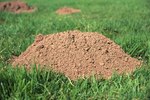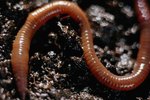It’s not difficult to detect a mole invasion in your backyard. The telltale raised ridges in your lawn are a sure sign that a mole lives there. Moles live in most of the continental United States in a variety of soils and habitats. While different species of moles have their own preferences regarding soil type, all species dig tunnels under the earth.
About Moles
Chances are you’ve seen moles depicted as characters in cartoons and children’s books. With their tiny eyes, lack of external ears, furry bodies and long snouts, moles have a very distinctive appearance. Moles use their sensitive snouts to locate food, which can include earthworms, snails, grubs, beetles and insects. Seven moles species live in the U.S., including the shrew, coast, broad-footed, hairy-tailed, eastern, star-nosed and Townsend’s moles. Male moles are slightly larger than females.
Habitat
Although all moles dig tunnels, their habitat preferences vary. Some moles, such as the star-nosed mole, like moist soil and live in bogs and marshes, while others, including the eastern and star-nosed moles, live in the drier soil found in wooded areas, meadows and fields. No matter what their preference, moles look for soil that permits ease of digging. Moles have no problem adapting to their surroundings. The Mole Catchers website notes that although some moles might prefer woodland areas, they have adjusted to living in suburban gardens and lawns. A key component of a good mole habitat is the ample availability of food, as moles need tremendous amounts of food each day. One mole can easily eat 70 to 100 percent of its weight in food each day.
Tunnels
Moles dig a network of tunnels underground as they search for food. The tunnels extend from the mole’s nest, or den, and range from 1 1/4 to 1 1/2 inches in diameter. Moles find dry spots underground to build their nests and pad the nests with soft layers of plant growth. They dig feeding tunnels through moist soil because worms, grubs and insects are more likely to live in wetter soil. Feeding tunnels are usually shallow and run just under the earth’s surface. Other shallow tunnels connect the feeding tunnels. During cold weather, moles dig deeper tunnels in search of worms and grubs that have moved farther underground in an attempt to escape freezing temperatures near the surface. Because moles create extensive tunnel networks, it might seem as if multiple moles are ruining your yard, but moles prefer to live alone. The Outwit Critters website advises that a mole must travel far to find enough food and notes that a tunnel network might be as large as two to three acres.
Identifying Mole Activity
Moles like ground that is moist enough to host a variety of food sources. If you water your lawn frequently, you might unwittingly create the ideal mole habitat. When moles burrow just under the surface of lawns, they destroy the roots of the grass. In addition to raised ridges in your lawn, you might notice areas of brown grass. Uneven surfaces also can be a sign of moles. Feeding tunnels are so shallow that they collapse if you step on them. They might also collapse during heavy rains or if you water your lawn with a hose.
References
Writer Bio
Working at a humane society allowed Jill Leviticus to combine her business management experience with her love of animals. Leviticus has a journalism degree from Lock Haven University, has written for Nonprofit Management Report, Volunteer Management Report and Healthy Pet, and has worked in the healthcare field.



